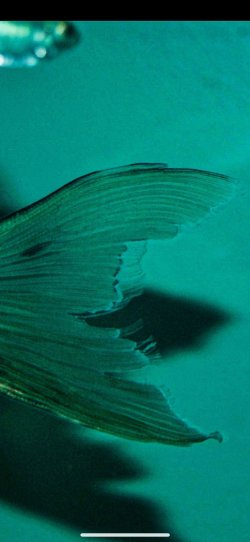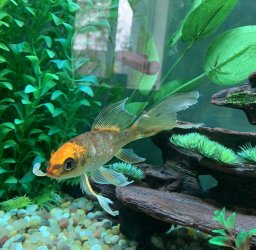You are using an out of date browser. It may not display this or other websites correctly.
You should upgrade or use an alternative browser.
You should upgrade or use an alternative browser.
Having trouble identifying this issue here.
- Thread starter KLG1234
- Start date
The April FOTM Contest Poll is open!

🏆 Click to vote! 🏆
Retired Viking
Fish Connoisseur
Hello and welcome to the forum. I had Koi in the past in my 55 gallon tank. I gave them up to a friend with a pond when they were getting too large. I will not attack you for bringing him in, In fact since he is only 4 inches long I see no problem in doing so. Makes sense to me, was he rubbing himself on something? Are those white dots like ick? I did not see anything like this with my Koi.
The fish has excess mucous and fin rot on the tail.
Excess mucous is usually caused by poor water quality or something in the water that is irritating the fish (chemicals or external protozoan infections).
Fin rot is caused by poor water quality that damages the skin and allows bacteria to get into the damaged tissue.
----------------
Check the water quality for ammonia, nitrite, nitrate and pH. You want 0 ammonia, 0 nitrite, less than 20ppm nitrate, and a pH above 7.0 for goldfish and koi.
What is the GH (general hardness) and KH (carbonate hardness) of your water supply?
This information can usually be obtained from your water supply company's website or by telephoning them. If they can't help you, take a glass full of tap water to the local pet shop and get them to test it for you. Write the results down (in numbers) when they do the tests. And ask them what the results are in (eg: ppm, dGH, or something else).
Goldfish and Koi need a GH above 150ppm for long term health.
Make sure any new water is free of chlorine/ chloramine before it is added to the tank.
Add some salt, see below.
You can add rock salt (often sold as aquarium salt), sea salt or swimming pool salt to the aquarium at the dose rate of 2 heaped tablespoon per 20 litres (5 gallons) of water.
If you only have livebearers (guppies, platies, swordtails, mollies), goldfish/ koi or rainbowfish in the tank you can double that dose rate, so you would add 4 heaped tablespoons per 20 litres.
Keep the salt level like this for at least 2 weeks but no longer than 4 weeks otherwise kidney damage can occur. Kidney damage is more likely to occur in fish from soft water (tetras, Corydoras, angelfish, gouramis, loaches) that are exposed to high levels of salt for an extended period of time, and is not an issue with livebearers, rainbowfish or other salt tolerant species.
The salt will not affect the beneficial filter bacteria but the higher dose rate will affect some plants. The lower dose rate will not affect plants.
After you use salt and the fish have recovered, you do a 10% water change each day for a week using only fresh water that has been dechlorinated. Then do a 20% water change each day for a week. Then you can do bigger water changes after that. This dilutes the salt out of the tank slowly so it doesn't harm the fish.
If you do water changes while using salt, you need to treat the new water with salt before adding it to the tank. This will keep the salt level stable in the tank and minimise stress on the fish.
Excess mucous is usually caused by poor water quality or something in the water that is irritating the fish (chemicals or external protozoan infections).
Fin rot is caused by poor water quality that damages the skin and allows bacteria to get into the damaged tissue.
----------------
Check the water quality for ammonia, nitrite, nitrate and pH. You want 0 ammonia, 0 nitrite, less than 20ppm nitrate, and a pH above 7.0 for goldfish and koi.
What is the GH (general hardness) and KH (carbonate hardness) of your water supply?
This information can usually be obtained from your water supply company's website or by telephoning them. If they can't help you, take a glass full of tap water to the local pet shop and get them to test it for you. Write the results down (in numbers) when they do the tests. And ask them what the results are in (eg: ppm, dGH, or something else).
Goldfish and Koi need a GH above 150ppm for long term health.
----------------
Do a 75% water change and gravel clean the substrate every day for a week. Then do a 75% water change and gravel clean the substrate once a week.Make sure any new water is free of chlorine/ chloramine before it is added to the tank.
Add some salt, see below.
----------------
For some fish diseases you can use salt (sodium chloride) to treat the ailment rather than using a chemical based medication. Salt is relatively safe and is regularly used in the aquaculture industry to treat food fish for diseases. Salt has been successfully used to treat minor fungal and bacterial infections, as well as a number of external protozoan infections. Salt alone will not treat whitespot (Ichthyophthirius) or Velvet (Oodinium) but will treat most other types of protozoan infections in freshwater fishes.You can add rock salt (often sold as aquarium salt), sea salt or swimming pool salt to the aquarium at the dose rate of 2 heaped tablespoon per 20 litres (5 gallons) of water.
If you only have livebearers (guppies, platies, swordtails, mollies), goldfish/ koi or rainbowfish in the tank you can double that dose rate, so you would add 4 heaped tablespoons per 20 litres.
Keep the salt level like this for at least 2 weeks but no longer than 4 weeks otherwise kidney damage can occur. Kidney damage is more likely to occur in fish from soft water (tetras, Corydoras, angelfish, gouramis, loaches) that are exposed to high levels of salt for an extended period of time, and is not an issue with livebearers, rainbowfish or other salt tolerant species.
The salt will not affect the beneficial filter bacteria but the higher dose rate will affect some plants. The lower dose rate will not affect plants.
After you use salt and the fish have recovered, you do a 10% water change each day for a week using only fresh water that has been dechlorinated. Then do a 20% water change each day for a week. Then you can do bigger water changes after that. This dilutes the salt out of the tank slowly so it doesn't harm the fish.
If you do water changes while using salt, you need to treat the new water with salt before adding it to the tank. This will keep the salt level stable in the tank and minimise stress on the fish.
Thank you so much for your reply. Unfortunately the fish in this photo passed awayHello and welcome to the forum. I had Koi in the past in my 55 gallon tank. I gave them up to a friend with a pond when they were getting too large. I will not attack you for bringing him in, In fact since he is only 4 inches long I see no problem in doing so. Makes sense to me, was he rubbing himself on something? Are those white dots like ick? I did not see anything like this with my Koi.
Retired Viking
Fish Connoisseur
I am sorry for your loss.Thank you so much for your reply. Unfortunately the fish in this photo passed away




